WMG News
Voi and Bumblebee Power partner on UK’s first wireless e-scooter charging trial launched at the University of Warwick
- Time-consuming and resource-intensive charging processes could be replaced by wireless charging for e-scooter rental fleets
- The ease of use for consumers and a reduction in operating costs through wider adoption of this technology would be a big advantage for the UK’s biggest rental scheme operator, Voi
- Trial in partnership with Bumblebee Power and WMG on the University of Warwick campus allows real-world testing in a ‘mini-city’ environment
- A successful trial will pave the way for seamless and convenient charging of e-scooters
Voi Technology, the UK’s largest e-scooter rental operator, has partnered with Bumblebee Power and WMG to trial the use of Bumblebee’s wireless e-scooter charging at the University of Warwick campus over a 6-month period potentially changing the future of the micromobility industry.
As with the charging of electric cars, the charging of e-scooters is a challenge for the operators of extensive rental schemes. The batteries powering their zero-emissions e-scooters are currently charged safely at their warehouse; however, they are replaced when vehicles are either receiving their regular in-house inspections or by the company’s in-field team who visit each e-scooter to perform fresh battery swaps.
These processes can lead to high operating costs for their business as the processes can be both time-consuming and often resource-intensive by requiring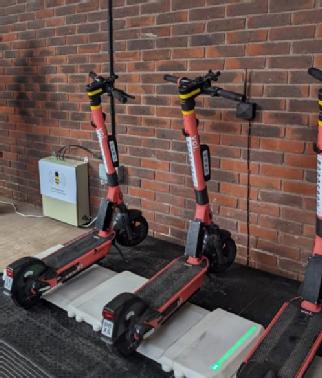 additional warehouse infrastructure for safe battery charging as well as transportation costs. Therefore, Voi began exploring new charging methodologies as a result that could provide the same excellent user experience whilst also delivering a similar vehicle efficient and effective battery performance. The potential solution: wireless charging.
additional warehouse infrastructure for safe battery charging as well as transportation costs. Therefore, Voi began exploring new charging methodologies as a result that could provide the same excellent user experience whilst also delivering a similar vehicle efficient and effective battery performance. The potential solution: wireless charging.
In partnership with Bumblebee Power, the wireless charging pads make it possible to charge e-scooters where they are parked, reducing not only operational costs but make their integration into the street and transport infrastructure more streamlined, making the modal shift to a convenient and flexible mode of transport easier for new and existing riders.
The University of Warwick campus ‘mini-city’ environment has been selected for this trial and provides an excellent, safe test bed for testing transport innovations. Available to estate staff only, a busy environment with a large population of students, staff, and industrial partners means the University of Warwick is an ideal ‘living lab’ environment to enable sustainable research and development of this technology.
The trial will provide data on the wireless system performance as well as user behaviour and interaction with the technology, which is crucial to any future large-scale deployment. If the trial proves successful it could be expanded to cover more of the Voi fleet across the UK.
David Yates, CTO of Bumblebee Power explains:
“The Bumblebee patented technology, which originated from Imperial College London, provides automatic connection via a very efficient wireless charging system, saving operational expenditure for the fleet operator by eliminating battery swaps. In addition, it makes possible the ability to extend the battery’s life, by controlling the charging regime whilst maximising vehicle availability.”
Sam Pooke, Senior Policy Manager at Voi UK and Ireland, said:
“We’re delighted to be partnering with Bumblebee Power to develop wireless charging for our e-scooters, an innovation that could change the whole micromobility industry.
“Applying this technology has the potential to not only reduce the operational impact of how we charge batteries for our vehicles but also in making an already convenient and flexible service even more accessible for new and existing riders. Over the coming months, we’ll look forward to working with our partners to maximise the innovative potential of this technology.”
David Evans, Lead Engineer at WMG, University of Warwick, said:
“Wireless charging technology for micromobility has the potential to reduce operational costs for fleet operators and provide a convenient charging solution for users. The University of Warwick campus is an ideal location to trial transport innovations such as these, providing a real world, mini city environment with world class teaching and research facilities.”
Researchers use smart roadside infrastructure and Vehicle-to-Everything technology to support connected and automated vehicles with motorway merging
As part of the AutopleX (Autonomous Cars Negotiating Complex Environments Using V2X) project consortium, researchers at WMG, University of Warwick,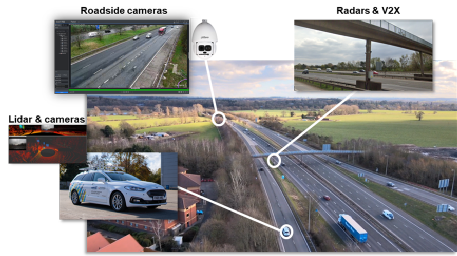 have used a connected smart roadside infrastructure and onboard vehicle systems to demonstrate how to enhance the vision and perception of future autonomous vehicles to achieve safer and more comfortable manoeuvres along high-speed junctions, such as motorway merges.
have used a connected smart roadside infrastructure and onboard vehicle systems to demonstrate how to enhance the vision and perception of future autonomous vehicles to achieve safer and more comfortable manoeuvres along high-speed junctions, such as motorway merges.
The Centre for Connected and Autonomous Vehicles (CCAV) and Innovate UK have jointly funded £2.6m for the collaborative R&D project AutopleX between March 2019 and September 2022.
AutopleX brought together WMG and leading automotive and mobility management partners Jaguar Land Rover (JLR) and Yunex Traffic, as well as public bodies such as Transport for West Midlands (TfWM) and National Highways.
Supported by the WMG Centre High Value Manufacturing Catapult, engineers and researchers at WMG have built a proof-of-concept demonstrator, where technology within a test vehicle (also known as “the EGO vehicle”) including Global Navigation Satellite Systems (GNSS), LiDAR and cameras, was fused with infrastructure-based sensing received over a Vehicle-to-Everything (V2X) communication system. This created a more comprehensive understanding of the environment in which the vehicle was travelling.
Colin Teed, AutopleX Project Manager at Jaguar Land Rover, stressed that: “Merging at high-speed junctions will be a standard action autonomous vehicles must perform and constitutes an important step in realising the vision of connected and automated mobility.”
Professor Mehrdad Dianati, Head of Intelligent Vehicles Research at WMG, added: “Onboard sensors may suffer from several limitations such as occlusions, limited range, and other forms of impairments. Especially at motorway junctions, where the speed of vehicles is usually high, undetected traffic objects by the onboard sensor suite can impose severe threats on safety. Onboard perception can, therefore, become insufficient as a standalone solution for level 4 autonomy. In this regard, the AutopleX project has developed a proof-of-concept solution that combines, in real-time, the onboard perception of a connected vehicle approaching a motorway with infrastructure-based sensing for supporting a safe merge.”
The AutopleX showcase demonstration took place via a live road traffic environment at Junction 15 of the M40 in March 2022. Yunex Traffic developed the roadside perception system, including three radars and V2X communication technology, while National Highways ensured its safe installation and effective operation.
Jet Feng, Project Engineer at WMG, explained: “The roadside perception including the locations, speed and steering angle of motorway vehicles was continuously broadcast (in the form of collective perception messages (CPMs)) and received by the vehicle’s onboard communication unit (OBU) on the Open Innovation Vehicle Platform whilst approaching the merging point of the junction. The received information was then combined with the onboard perception to improve the overall understanding of the environment and was visualised in real-time via a bird’s eye view map of the junction, allowing the passengers to observe road traffic objects along the M40, which were not otherwise visible due to occlusions.”
Furthermore, WMG and Jaguar Land Rover researchers jointly developed intelligent trajectory-planning algorithms, which utilised the combined perception to design a high-speed merging manoeuvre that is efficient, smooth, and safe.
Dr Konstantinos Koufos, Senior Research Fellow at WMG, commented: “While the Open Innovation Vehicle Platform was driven by a human driver, the calculated trajectory, including speed and steering, of a hypothetical vehicle using the combined perception was visualised in real-time on the in-vehicle monitors. This allowed the passengers to compare the trajectory of the hypothetical (or ghost) vehicle with the actual trajectory of the human-driven vehicle. Key performance indicators (KPIs) associated with road safety and passenger comfort were also calculated and compared during the merging manoeuvre. The next major step would be to engage the calculated trajectory of the ghost vehicle with the drive-by-wire system of the Open Innovation Vehicle Platform.”
The project successfully implemented and demonstrated the developed technology, collecting, annotating and processing vast datasets including over eight months of road traffic data using 10 infrastructure cameras and three RADARs. These datasets could be made available to selected organisations outside of the AutopleX consortium for user trials and feedback. In addition, it constitutes valuable R&D data that can be used in WMG’s Doctoral Training Centre in Future Mobility Technologies, as well as WMG’s MSc programme in Smart Connected and Automated Vehicles (SCAV).
Learn more about the vehicle used in the demonstration: https://warwick.ac.uk/fac/sci/wmg/research/cav/ivfac/catapult-open-innovation-vehicle/
Explore research in WMG’s Intelligent Vehicles Group: https://warwick.ac.uk/fac/sci/wmg/research/cav/
Innovate UK: https://www.ukri.org/councils/innovate-uk/
Centre for Connected and Autonomous Vehicles: https://www.gov.uk/government/organisations/centre-for-connected-and-autonomous-vehicles
WMG High Value Manufacturing Catapult:
https://hvm.catapult.org.uk/centre/wmg/
New Chief Technology Officer appointed at the WMG centre for High Value Manufacturing Catapult (HVMC)
WMG centre for High Value Manufacturing, at the University of Warwick, has welcomed its new Chief Technology Officer (CTO), Simon Webb.
Simon, who was previously Head of Zero Carbon Strategy for the Aerospace Technology Institute (ATI), has over 20 years’ experience in aerospace engineering, technology and strategy leadership.
Prior to this, he was the Chief of Technology and Digital (Civil Aerospace) at Rolls-Royce, responsible for a portfolio of technology strategy and execution programmes globally.
Simon has a background in leading the development, design and manufacture of aerospace engines including the engineering teams on the world’s most efficient large aero-engine, the Trent XWB, and more recently the Rolls-Royce Titanium-Composite Fan System development activity.
He also sits on the board of directors for the JetPerfect Foundation, focusing on zero carbon flight technologies; and the technical advisory board of the ENABLE-H2 hydrogen research programme led by Cranfield University.
With his extensive industrial and technical background, Simon will help continue WMG’s work to accelerate new concepts in manufacturing into commercial reality, helping businesses tackle challenges with innovations in technologies, processes and materials.
Simon Webb comments: “I’m delighted to be joining WMG as Chief Technology Officer and by extension being part of the University of Warwick. I’m looking forward to further developing and applying the technologies and capabilities WMG has to offer into industry, and in doing so improving the sustainability of our transportation network and beyond. I expect to work closely across the High Value Manufacturing Catapult network to integrate our capabilities and so maximise the benefits to industry, the UK, and our global partners.”
Professor David Greenwood, CEO of WMG centre High Value Manufacturing Catapult says: “We are delighted to welcome Simon to the team. He brings with him a wealth of experience in aerospace and digital manufacturing, centred around zero carbon propulsion. Simon’s aerospace expertise broadens our depth of knowledge at WMG, and we are looking forward to learning more from him.”
Professor Chris Dungey, High Value Manufacturing Catapult CTO, says: “Simon is joining the HVMC family at an exciting time. We are entering a new chapter which will see the Centres across the network working more collaboratively than ever before, and I am looking forward to working with Simon and the wider CTO team to help the Catapult deliver industrial transformation for the UK.”
Find out more about the High Value Manufacturing Catapult centres here: https://hvm.catapult.org.uk/
University of Warwick wins £1 million grant to help UK get ready for electric vehicles
- The funding will be used to launch a new programme called the Warwick Electrification Deployment (WELD)
- WELD will be contributed to by WMG's Power Electronics, Machines and Drives (PEMD) Group and the School of Engineering's Power Electronics group
- These two world class research groups will use Warwick’s unique facilities, as well as the university’s manufacturing and testing capability to help in the new education programme
- WELD is one of the winners of the ‘Driving the Electric Revolution: Building Talent for the Future 2’ competition, run by Innovate UK
- The new initiative will include industry workshops, outreach activity in school and increased teaching provision within PEMD
New content in power electronics, eMachines and drives will also be created at the University to use current expertise to both up-skill the existing workforce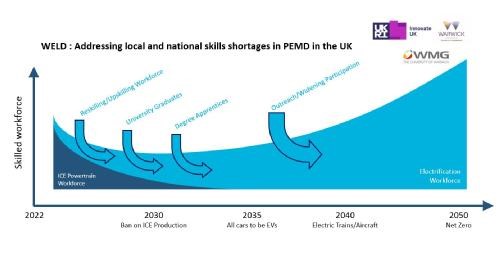 and support the pipeline of talent for future generations.
and support the pipeline of talent for future generations.
Finally, WELD will also focus on the design of IP-free eMachines, with parts manufacture, assembly and testing on campus to allow for hands-on learning.
As both transport and industrial equipment pivots from combustion technology to electrical power, skills for the design, manufacture and maintenance of electric drivetrains are increasingly in demand.
WELD will benefit from the two ‘Driving the Electric Revolution Industrialisation’ (DER-IC) facilities at the university: the Winding Centre of Excellence and the power electronics reliability and failure analysis space, both launching in Autumn 2022. The trained workforce will help UK businesses to develop and scale new PEMD technologies and manufacturing processes.
Dr Juliette Soulard, Associate Professor Electric Machines at WMG says: “Through our close collaboration with UK industry, we witness the huge difficulties faced when trying to recruit people with the right skills for PEMD research and development projects.
“The expertise exists in the UK, but the knowledge and skills transfer needs dedicated and urgent actions which normal higher education courses cannot deliver. WELD’s industry workshops with unique, hands-on learning about manufacturing and device testing aims to address this issue.”
Prof. Peter Gammon, Professor of Power Electronic Devices, Head of Research and Deputy Head of the School of Engineering says: “We are extremely proud to be leading the WELD project, which will help meet a national and international PEMD skills shortage.
“Our activities will also help increase the flow of engineering graduates into the industry via new PEMD and Automotive Electrification MScs, while an extensive outreach programme will help educate and inspire the next generation of engineers.”
ENDS
Note to Editors:
Useful Links:
Driving the Electric Revolution - Industrialisation Centres
WMG, University of Warwick
WMG is a world leading research and education group, transforming organisations and driving innovation through a unique combination of collaborative research and development, and pioneering education programmes. As an international role model for successful partnerships between academia and the private and public sectors, WMG develops advancements nationally and globally, in applied science, technology and engineering, to deliver real impact to economic growth, society and the environment.
WMG is one of the founding partners of the High Value Manufacturing (HVM) Catapult and leads HVM Catapult activities on Transport Electrification and Connected and Autonomous Mobility. The Catapult network’s mission is to leverage research and educational expertise to de-risk innovation for UK manufacturing, to improve business resilience, productivity, competitiveness and sustainability.
School of Engineering, University of Warwick
The School of Engineering benefits from its multidisciplinary approach, with research covering a broad range of topics. Key themes of Energy, Biomedical Engineering, and Future Cities, Materials and Manufacturing, and Technology and Society provide a framework to the research efforts, which are underpinned by four discipline streams and fourteen research groups. The School employs some of the leading engineers in their field, who regularly publish papers in top ranking journals. There are currently over 150 students undertaking postgraduate research degrees and 55 65 research post-doctorate staff.
DER-IC
DER-IC (Driving the Electric Revolution Industrial Centres) is building a globally recognised, sustainable UK-wide network with the relevant skills and capabilities to deliver the PEMD (power electronics, machines, and drives) necessary for a net zero future in all relevant applications. The network of DER-IC is instrumental in the UK’s progress towards its 2050 net zero target and a world leading response to the realisation of the industrial technology (IDT) revolution.
DER-IC is funded by UK Research and Innovation and was set up in 2020 as part of the Driving the Electric Revolution challenge.
DER-IC provides open access facilities to over £300 million worth of state-of-the-art equipment, bringing together the UK’s technology and manufacturing expertise in electrification research and development.
§ DER-IC is creating cost-effective, UK-based technologies and solutions, with export market opportunities, to help address and support climate change
§ DER-IC is educating about the art of what’s possible for governments, industry, academia, and schools
§ DER-IC is an industry led project which has so far engaged with 400 industrial organisations, as well as having 30+ academic institutions and RTO’s in its network
Flagship Coventry transport project takes a major step forward to net zero
- Real-world urban highway demo site of innovative rail track system for Coventry Very Light Rail (CVLR) unveiled on University of Warwick campus
- Testing facility will allow simulation of various scenarios, enabling active engagement with key stakeholders including utility companies and city transport planners
- WMG and Ingerop engineers have capitalised on advanced material and manufacturing processes developed over recent years
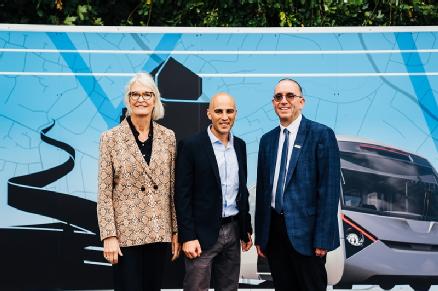 The Coventry Very Light Rail Project (CVLR) has taken a major step forward, as Coventry City CouncilLink opens in a new window and WMG, at the University of Warwick, launch a real-world demo site for its light rail track system.
The Coventry Very Light Rail Project (CVLR) has taken a major step forward, as Coventry City CouncilLink opens in a new window and WMG, at the University of Warwick, launch a real-world demo site for its light rail track system.
The site, based at WMG, University of Warwick, gives stakeholders a snapshot of what’s to come in Coventry, when the first phase of the city route commences.
Using advanced material and manufacturing processes, researchers and engineers at WMG have worked alongside track-design experts at IngeropLink opens in a new window to create, design and build the demo site including the unique track system, which is not only more affordable to install but also enables rapid installation - minimising disruption to local properties and businesses.
The track form, designed to sit within the top 30cm of existing highway surfaces, is easy to install and can be removed rapidly; significantly reducing clashes with utilities and potentially saving millions of pounds otherwise spent on excavation and moving gas, electrical and telecommunication systems when installing more traditional track forms. With installation costed at approximately £10m per km, the track is significantly cheaper compared to current tram tracks which can cost upwards of £25m per km, and significantly more in city centre locations.
The new track has been developed in parallel to a zero-emission, battery-powered lightweight shuttle vehicle created in partnership with TDi. The vision of Coventry Very Light Rail is that as technology matures it will become autonomous and work similarly to the London Underground system, where service is frequent and passengers can hop on and off.
The vehicle itself is lightweight, and there will be no overhead power supply along the route, significantly reducing infrastructure costs, complexity and visual impact on the city-scape.
Councillor Jim O’Boyle, Cabinet Member for Jobs, Regeneration and Climate Change, said: “This new track test site is a key part of our work to demonstrate the viability of the breakthrough technology in this track. In a world first, we’re aiming to keep pipes and cables in the ground, lowering installation costs and making Coventry Very Light Rail possible in our city and across the country.
“Coventry Very Light Rail will form the backbone of our future transport network, but we’re investing in many projects to make our city’s transport cleaner, greener and more convenient for residents. Coventry Very Light Rail will fit seamlessly with our plans to be the UK's first all-electric bus city and our plans to continue to provide more on-street electric charge points than anywhere outside London.”
Following installation at the University of Warwick, Coventry City Council will install test track at its Whitley Depot waste facility to test it with heavy goods vehicles, and also at the Very Light Rail National Innovation Centre (VLRNIC) in Dudley, where vehicle testing is currently taking place. The installation will form part of the facility’s 15m radius loop, built to test the CVLR prototype vehicle’s cornering system and will enable full system integration testing to be undertaken.
Dr Christopher Micallef, Principal Engineer at WMG, University of Warwick comments: “The University of Warwick urban track demonstration site provides an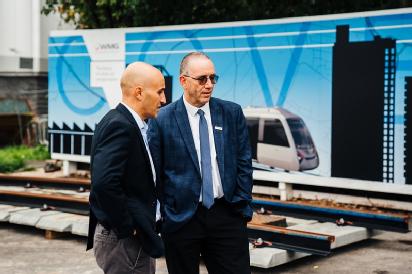 ideal scenario to prove-out the installation methods of the novel track system. The site will enable various competing sub-systems such as the encapsulation and pavement systems to be trialled to further explore the advantages and challenges.
ideal scenario to prove-out the installation methods of the novel track system. The site will enable various competing sub-systems such as the encapsulation and pavement systems to be trialled to further explore the advantages and challenges.
“The site includes features such as water drainage gullies, buried utilities and a sewage access chamber to ensure that solutions to these real-world complexities can be explored. After the first phase, which is all about the track installation process, the site will be further utilised to allow various scenarios to be simulated and enable active engagement with key stakeholders such as utility companies, materials and subsystems supply chain and city transport planners. Eventually it could provide a facility to train the next generation of track installation teams.”
Andy Street, Mayor of the West Midlands, said: “This very light rail project is a fantastic demonstration of collaboration across our region – whether it’s the development at Dudley, this new test track at Warwick University or soon enough the first route in Coventry city centre.
“The West Midlands Combined Authority is investing £71.5m into very light rail. Designing and building a light rail service rapidly and at a fraction of the cost of regular Metro lines has the potential to transform our public transport network. It is also a great example of cutting edge innovation that can help us to meet our #WM2041 net zero commitment and tackle the climate emergency. Our region is ideally placed to become the home of the green industrial revolution.”
Coventry Very Light rail is being led by Coventry City Council and has received funding from the West Midlands Combined Authority, the Coventry and Warwickshire Local Enterprise Partnership and Coventry City Council.
-ENDS-
WMG’s SME group receive double award at the Technology Supply Chain Awards
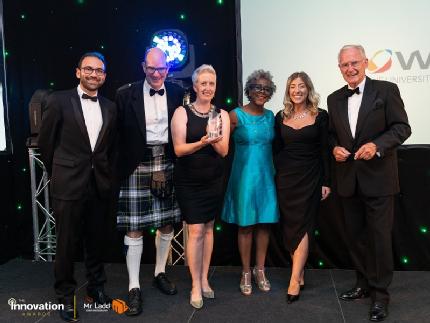 WMG’s SME group have been awarded as manufacturing innovation champions for their work with Midlands manufacturers at an awards ceremony held in Birmingham by membership group – the Technology Supply Chain.
WMG’s SME group have been awarded as manufacturing innovation champions for their work with Midlands manufacturers at an awards ceremony held in Birmingham by membership group – the Technology Supply Chain.
They were celebrated for the delivery of the DI4M (Digital Innovation for Manufacturing programme), a four-year project funded by the High Value Manufacturing Catapult and ERDF (European Regional Development Fund) to aid SME manufacturers adopt digital technology for increased productivity and profitability.
Over 300 businesses have already benefited from one-to-one project support from WMG experts to implement automation, new information systems, and digital manufacturing techniques with transformative results.
One of the beneficiaries of the programme, Daniel Robinson, Head of Finance, Operations & I.T, Gordon Ellis & Co said: “We’ve spent over 150 years in the industry. We know it well, however, we are looking to the future and need to use digital to continue to be innovative and competitive. WMG have the know-how in smart factories, and we got support that we wouldn’t have got anywhere else.”
Dr Mark Swift, Head of SME Programmes at WMG, University of Warwick said: “We are delighted to have received this award in recognition of our work with the Midlands manufacturing community. Our team cut through the technical jargon to get things done. From quick wins, helping businesses minimise waste in a process to longer term projects, implementing technology such as sensors and cameras to better track production throughput. The results can be transformational for businesses who are having to navigate some of the most challenging times.”
WMG were also jointly awarded the engineering innovation champion prize for delivery of the Made Smarter programme with partners at the Coventry and Warwickshire Growth LEP Hub, West Midlands Combined Authority and the Manufacturing Technology Centre (MTC).
World’s largest scenario database for Automated Vehicles is now open to public - Safety PoolTM Scenario Database
- Safety Pool™, led by WMG at the University of Warwick and Deepen AI, launches public access to the over 250,000 scenarios via a credit system
- Organisations can now earn credits for their scenario contributions to the database
- Credits can be used to access the entire set of scenarios in the database
- UK’s Vehicle Certification Agency is evaluating the use of Safety PoolTM as part of future type approvals of Automated Vehicles
Leading experts at WMG at the University of Warwick and Deepen AI, have launched credit-based access to the largest public store of scenarios for testing automated vehicles. The Safety Pool™ Scenario Database, features over 250,000 different scenarios. WMG and Deepen AI are also working with regulators internationally to help evaluate the safety of Automated Vehicles using the Safety PoolTM Scenario Database.
Safety remains one of the biggest challenges around self-driving vehicles. Driven by Safety PoolTM ’s vision of safety of self-driving vehicles being pre-competitive, the Safety PoolTM Scenario Database has created an ecosystem to enable sharing of test scenarios amongst organisations worldwide.
The database provides a large range of scenarios in different operational design domains (ODDs i.e., operating conditions) that can be leveraged by governments, industry, and academia alike to test and benchmark Automated Driving Systems (ADSs). Bolstered by scenarios generated by novel scenario generation methods: 1) knowledge-based and 2) data-based, a methodology also mentioned by the EU’s Regulatory Act on Automated Driving Systems, scenarios in Safety PoolTM are focused on uncovering failures in automated vehicles as they capture those edge-case scenarios.
Under the credit system, users are rewarded with credits for submitting scenarios to the database. Contributions are scored based on uniqueness of the scenarios and their validity, and corresponding credits are awarded to the organisation. These credits can be redeemed to gain access to more scenarios. This system encourages users to contribute to growing the database and making more scenarios available to the self-driving vehicle community.
Dr Siddartha Khastgir, Head of Verification & Validation, at WMG, University of Warwick, said: “With the public launch of the Safety Pool™ Scenario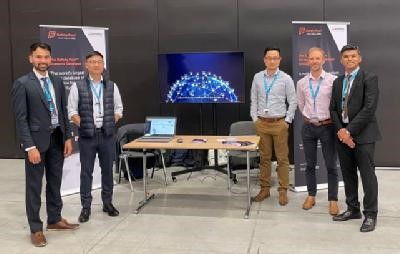 Database, we are democratizing critical data that was not easily available in the ecosystem. By aligning with international standards and working closely with regulators and developers in the UK and internationally, we are driven by the mission of making safety of automated vehicles pre-competitive.”
Database, we are democratizing critical data that was not easily available in the ecosystem. By aligning with international standards and working closely with regulators and developers in the UK and internationally, we are driven by the mission of making safety of automated vehicles pre-competitive.”
Jamie McFaden, Head of Automated Vehicle Technologies Group, Vehicle Certification Agency said: “The Vehicle Certification Agency, the UK’s Type Approval Authority, recognises the importance of ODD based testing and as a result is evaluating the use of Safety PoolTM Scenario Database as part of the Type Approval process for Automated Driving Systems.”
Coherent with our mission to align with international standards, today, each scenario has been launched in ASAM OpenScenario 1.1 and ASAM OpenDRIVE 1.6 formats. This provides further interoperability between stakeholders using ASAM OpenX standards for their simulation-based testing of automated vehicles.
The scenarios also cover a diverse set of ODD attributes and manoeuvre types such as urban environments, highways, and under varied environmental conditions where vehicles perform different manoeuvres such as cut-ins, overtaking etc. Use cases supported include Automated Lane Keeping Systems, low-speed shuttle, urban level 4, highway ADAS etc. Scenarios can also be efficiently searched using the ODD and Behaviour tags as per ASAM OpenLabel standard.
With Safety Pool™, industry, academic, industry and government experts come together to create the standards that will make the operation of automated vehicles safe everywhere. This builds an environment which enables the uptake of automated and autonomous technology in road vehicles.
Mohammad Musa, CEO, Deepen AI, said:
“By contributing and working within the Safety Pool™ framework, commercial stakeholders across AV fleet operators, OEMs, Tier 1 suppliers and all other Tier 2+ suppliers can massively accelerate verification & validation as well as share insights & edge cases that are very hard for a single stakeholder to collect by themselves.”
Eric Barbier, Head of Safety, Wayve said:
“Safety is core to the development of automated vehicles and everything we do at Wayve. As an industry, it is essential that we collaborate around a common ecosystem for safety assurance. Wayve is excited by the opportunity unlocked by the Safety Pool™ initiative and we look forward to leveraging its extensive database of curated scenarios.”
Since the launch of this pioneering project in March 2021, WMG at the University of Warwick and Deepen AI have collaborated with stakeholders around the world. To date, over 450 organisations have enrolled in the Safety PoolTM Scenario Database. The next step in WMG’s activity is working closely with regulators in the UK and internationally on enabling a safety assurance for automated vehicles through the Safety PoolTM Scenario Database.
Dr Maria J. Alonso, Lead, Automotive in the Software-Driven Era Initiative, World Economic Forum said:
“Collaboration among stakeholders is key to ensure that autonomous vehicles offer the highest possible levels of safety. The Safety PoolTM Scenario Database, with its over 250,000 scenarios and its collaborative approach, provides a platform to contribute to safer mobility on our roads.”
The development of the Safety Pool™ Scenario Database was funded by UK’s Centre for Connected & Autonomous Vehicles (CCAV), Innovate UK and Zenzic funded Midlands Future Mobility project led by WMG, University of Warwick. Furthermore, the WMG centre for High Value Manufacturing Catapult has further supported the continuous enhancements of the database with its support to the Verification & Validation team at WMG.
Notes to editors:
University of Warwick press office contact: Simmie Korotane | Media Relations | Press & Media Relations | University of Warwick | Email: Simmie.korotane@warwick.ac.uk
Useful Links:
Link to Safety PoolTM videos: https://youtu.be/edxw_VhzAYA
Link to Safety PoolTM website: https://www.safetypool.ai/
Link to Safety PoolTM Knowledge base: https://docs.safetypooldb.ai/
WMG welcomes representatives from the Steel All-Party Parliamentary Group
It was an honour to welcome Stephen Kinnock MP and Jessica Morden MP, Chair and Vice Chair respectively, of the Steel All-Party Parliamentary Group (APPG), to WMG at the University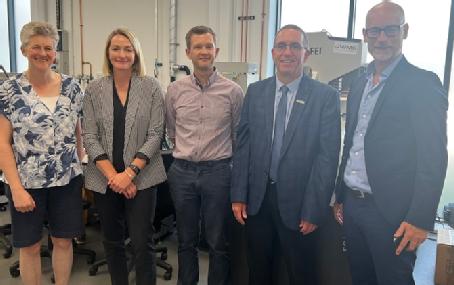 of Warwick this week.
of Warwick this week.
The guests were met by Professor Claire Davis and Dr Russell Hall from the Advanced Steel Research Centre, and Dean of WMG, Professor Robin Clark.
They enjoyed a tour of the Advanced Materials and Manufacturing Centre (AMMC), home to WMG’s world-class steels research facilities, where they heard more about WMG’s work to support the steel industry including the importance of green steel production for a sustainable future.
Stephen Kinnock MP Chair of the Steel APPG and Jessica Morden MPVice Chair of the Steel APPG commented: “It was great to visit Claire Davis and her team at WMG's Advanced Materials Manufacturing Centre to see for ourselves the industrial research and development they're working on with the UK Steel sector, including cutting the cost of developing new steel alloys, deploying alternative fuels for green steel production or converting scrap steel to high value products.
“Innovation has a crucial role in improving the quality of UK steel production, reducing energy costs and making UK steel sustainable and it was heartening to see academics and industry working together on these critical issues for the future of UK steel, which is so important for our country."
Professor Claire Davis said: “Stephen and Jess were really interested in hearing about the work we do in the Advanced Steel Research Centre. It was great to show them examples of our fundamental and applied research supporting the development of new steel processing and alloys, and the impact it has for the UK steel industry. It is a very exciting, and challenging time to be working on steel due to the pace of change as we move to green steel production.”
Find out more about WMG’s Steels Processing research here: Steels processing (warwick.ac.uk)
Student projects help graduates to develop key employability skills
WMG, at the University of Warwick, is committed to supporting a variety of undergraduate student projects with connections to industry partners.
Each student project is supported and supervised by WMG Precision Engineer Dave Cooper, who has a background working for Honda Racing, and Lead Engineer Malcolm Swain, who specialises in electric vehicle battery technology.
The projects also engage with WMG PhD students; academics; technicians and industry sponsors. Students gain valuable practical and project management skills by being assigned an area of responsibility, from engineering and technical lead to marketing and sales support.
The student-led projects help to develop time and management skills; teamwork; and give practical hands-on experience.
While WMG provides some seed funding, it is the responsibility of the students to secure sponsors and funding, learning valuable networking, negotiation, sales and partnership skills along the way.
2022 student project teams
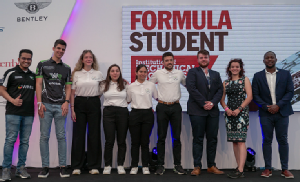 The Warwick Racing team entered the IMeche Formula Student Concept Class event at Silverstone to assess their new concept for an in-house built chassis. The judges, including an engineer from Mercedes F1 chassis team, were very positive about its ease of manufacture, lightweight, functionality, recyclability and cost saving design. The team is now developing the chassis based on the judges’ feedback to test its feasibility in the next electric racing car.
The Warwick Racing team entered the IMeche Formula Student Concept Class event at Silverstone to assess their new concept for an in-house built chassis. The judges, including an engineer from Mercedes F1 chassis team, were very positive about its ease of manufacture, lightweight, functionality, recyclability and cost saving design. The team is now developing the chassis based on the judges’ feedback to test its feasibility in the next electric racing car.
The Warwick Racing Business team was awarded second place for its business presentation out of 51 top global universities. The event follows a similar format to Dragon's Den, with the students developing a business idea, plan and model for producing the electric racing car to sell. This is an extremely challenging event and the team have high hopes to win first place next year.
In the Warwick Moto team, student technical lead Nesta Ferguson, was awarded the Best Dissertation Project Award, by the Institute of Mechanical Engineering, and recognised as a runner-up in the Engineering Undergraduate Innovation Award category. The Team’s research outputs were also accepted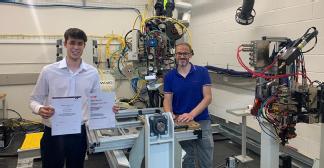 for publication by the flagship ICALEO conference and then promoted to the Journal of Laser Applications. Aneesh Jois, who also played a leading role in the Warwick Moto team, won Institution Best Student on the Mechanical Engineering Bachelor’s degree for academic achievement. Aneesh highlighted how invaluable his Warwick Moto project experience has been in learning how to design components for use in the real world and enabling him to achieve higher grades in application-based engineering modules.
for publication by the flagship ICALEO conference and then promoted to the Journal of Laser Applications. Aneesh Jois, who also played a leading role in the Warwick Moto team, won Institution Best Student on the Mechanical Engineering Bachelor’s degree for academic achievement. Aneesh highlighted how invaluable his Warwick Moto project experience has been in learning how to design components for use in the real world and enabling him to achieve higher grades in application-based engineering modules.
The Warwick Robotics team worked with Dr Rachel Edwards, in the Department of Physics at the University of Warwick, to develop two wall climbing robots which perform Non-Destructive Testing (NDT) on steel structures such as storage tanks and wind turbine towers. The twin robots work in tandem carrying an electromagnetic acoustic transducer (EMAT), one with the receiver and one with the transmitter. To achieve the best results quickly the two robots must climb the structures with the transmitter and receiver aligned with each other at various distances apart. The students designed, built and tested a system that did this automatically in real-time using high resolution cameras and fiducial markers achieving +/-0.45degree accuracy. This will revolutionise industrial applications of NDT where this was considered not viable in the past.
Lee-Rose Jordan, Project Manager at WMG, University of Warwick explained: “These projects are a great example of how students can develop valuable hands-on engineering knowledge and skills, standing them in good stead as they embark on their chosen careers in some of the most esteemed companies in the world. This year, for example, some of our students have gone on to work at Delta Cosworth, Williams Advanced Engineering, McLaren Applied, Triumph, Alpine F1 and Mercedes.”
Find out more about the student projects here: Student Led Projects (warwick.ac.uk)
WMG supports unique community project inspired by Daniel Lismore
The WMG Outreach and SME teams, at the University of Warwick, were pleased to lend their support to the Herbert Art Gallery & Museum, for a unique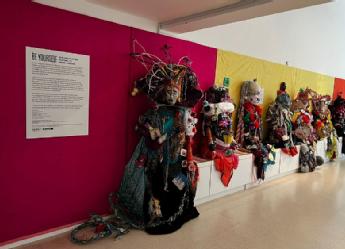 project inspired by Coventry artist and campaigner, Daniel Lismore.
project inspired by Coventry artist and campaigner, Daniel Lismore.
The gallery hosted a series of masterclasses challenging local community groups to create their own mannequins using the techniques and skills adopted by Daniel in his recent exhibition ‘Be Yourself, Everyone Else is Taken.’
Daniel Lismore is known for his elaborate and extravagant creations that combine haute couture with charity-shop finds, including yards of vintage fabrics, found objects, ribbons, feathers, chain mail, shells, ethnic jewellery and retro accessories in an expression of creative energy, whilst giving voice to social calls for action and politically driven campaigns.
The Herbert Art Gallery & Museum approached Professor Margaret Low, Director of Outreach and Widening Participation at WMG, in need of some specialist equipment to help with the masterclasses. The WMG SME Team owned this equipment, and kindly agreed to loan it.
Amanda Haran, Community Engagement Officer at Culture Coventry explained: “Daniel was introduced to vacuum forming by English National Opera and as our aim was to make the creative journey as artistically authentic as that taken by Daniel, we were thrilled when the team at WMG offered the use of their machine.”
Bethany Haynes, Engineering Technician in the WMG SME Team, attended each of the masterclasses and guided the community groups through the vacuum forming process, enabling them to create some really imaginative pieces, combining engineering skills with process art.
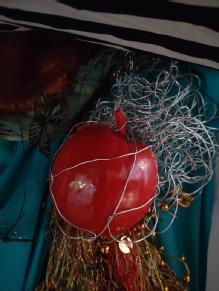 Bethany explains: “No object, providing it could withstand the heat, was off limits. We used key rings, broken bits of jewellery, fabrics and even real apples.
Bethany explains: “No object, providing it could withstand the heat, was off limits. We used key rings, broken bits of jewellery, fabrics and even real apples.
“It was a brilliant project to work on, totally different from anything I’ve done before, and it was lovely to have the freedom to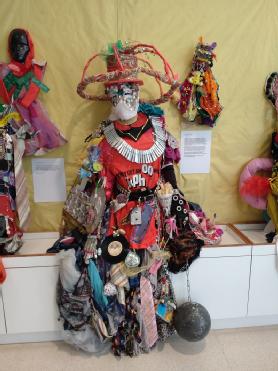 add my own ideas to the designs too.”
add my own ideas to the designs too.”
Amanda added: “Beth's instruction and support have been truly amazing, from making pomegranate moulds, to sourcing the specialist preferred foam. She met the energy of the groups being encouraging and adventurous, helping them to create the forms that best illustrate their theme.”
The Daniel Lismore inspired mannequins will be on display at the Herbert Art Gallery & Museum throughout August. Find out more here: Home - The Herbert Art Gallery & Museum
